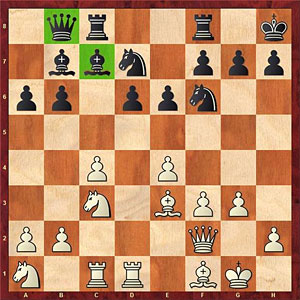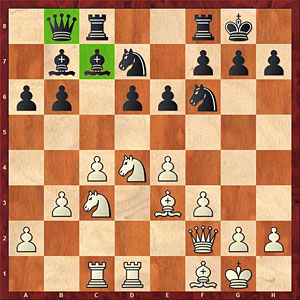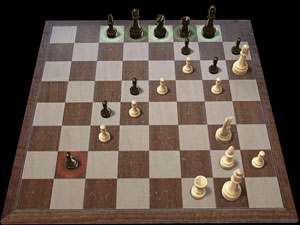
Baseline Chess, Hedgehog and Magnus Carlsen – Part two
By GM Lubomir Kavalek
Ljubomir Ljubojevic is credited with developing the Hedgehog in the modern era – in the early 1970s. Ljubo rarely missed a dynamic opportunity and the counterpunching Hedgehog was a perfect fit for him. He discussed the defense with Andersson and they became the Hedgehog brothers. The opening played a big part in their success. In 1983, they were rated just behind Anatoly Karpov and Garry Kasparov: Ljubo was third and Andersson fourth on the FIDE rating list.
According to available sources, the Hedgehog was first played in Czechoslovakia by Fritz Sämisch against Karel Opocensky in a tournament in the Slovakian spa of Pieštany in 1922.
Opocensky, Karel - Sämisch, Fritz
Pieštany 1922

We see the position with all the ingredients of the Hedgehog, the spiny black pawns on the sixth rank and the pieces hiding behind them. We also see the battery, queen and bishop, that Andersson employed with the white pieces 52 years later.
We know Sämisch influenced the opening theory with variations in the Nimzo and King's Indian defenses. His contribution to the Hedgehog was less obvious, hidden for years.
Salo Flohr, the all-time finest Czech player, used Sämisch's setup in the game against Karel Treybal in Ujpest in 1934.
Treybal, Karel - Flohr, Salo
Budapest 1934

In 1937, FIDE chose Flohr to be the official challenger for the world championship match against Alexander Alekhine. But the match never took place and in 1939 Flohr emigrated to Soviet Union where he had to compete with many talented players.
Flohr was an excellent chess journalist. We worked together in 1966, commenting on the world championship match between Boris Spassky and Tigran Petrosian for a Czech daily. I was in Prague, Flohr was in Moscow. I got all gossip from him with many marvelous details, including the color of Petrosian's socks. Telephone was our connection. Today you can see Carlsen's socks on your smartphone.
Technology dominated the coverage of the match in Chennai. Internet reporting was massive: chess twitterati with analytical engines tried to outdo themselves like the old court wits, chess was also big on Facebook. And we should not forget the millions of television viewers. What a leap forward in the last 50 years!
I noticed that the match was getting personal during Game 3. After the first 10 moves, Carlsen reached the same position I had 40 years ago against Arthur Bisguier, although the move order was different. We both spread the white pieces on the first three rows, only our queen was floating around, waiting to be chased back any moment.
Anand, Viswanathan - Carlsen, Magnus
World Chamionship, Chennai 2013, Game 3
and
Kavalek, Lubomir - Bisguier, Arthur
U.S. Championship, El Paso 1973
10...Nd4 10...Be6 11.Qa4 Nd4 12.Rfc1 a5 13.Qd1 Re8 14.Ne1 c6 15.e3 Ndf5 16.a3 Nd6= 11.Nxd4 exd4 12.Ne4 c6 13.Bb4 Be6 ½–½
- Start an analysis engine:
- Try maximizing the board:
- Use the four cursor keys to replay the game. Make moves to analyse yourself.
- Press Ctrl-B to rotate the board.
- Drag the split bars between window panes.
- Download&Clip PGN/GIF/FEN/QR Codes. Share the game.
- Games viewed here will automatically be stored in your cloud clipboard (if you are logged in). Use the cloud clipboard also in ChessBase.
- Create an account to access the games cloud.
| Carlsen,M | 2870 | Anand,V | 2775 | ½–½ | 2013 | A07 | WCh 2013 | 3 |
Please, wait...
Bisguier was one of the world's best experts on the Berlin defense (1.e4 e5 2.Nf3 Nc6 3.Bb5 Nf6) already in the 1960s despite his famous loss to Bobby Fischer at the 1963 U.S. Championship. The Petroff defense (1.e4 e5 2.Nf3 Nf6) was another opening he liked to play. When I could not get any advantage against him at the 1972 U.S. Championship in New York, I decided to improvise a year later with the reversed Pirc defense. To my surprise, Carlsen reached the same position. Time stood still for 40 years.
In the championship in El Paso in 1973 John Grefe played the tournament of his life, winning game after game. He had a marvelous run and was well prepared. He came up with many original and fascinating ideas. I was lucky to chase him down, and we shared the U.S. title. We thought that a new star was born, but John had other priorities. He returned to chess towards the end of his life. Sadly, he died on December 22 of last year at the age of 66.
Given a choice, Carlsen would prefer to fight against the Hedgehog. He knows what to do with space as he demonstrated in Game 10 against Anand. Another example was his victory against Judit Polgar in London in 2012, published in this column. That game was also included in Colin Crouch's fascinating book Magnus Force, published by Everyman Chess.

It is a 420-page journey into Carlsen's brain. There are only 28 games covering the time Carlsen broke Kasparov's record, but it allows Crouch to write many little essays into the comments, ranging from general remarks to specific advice. As usual, Crouch is on top of his writing game.
Whether you agree or disagree with Crouch, he always gives you an honest opinion. "Carlsen, despite the occasional recent glitches, is quite clearly an excellent handler of chess psychology," he writes. But may be it is more simple. "I don't believe in psychology," said Bobby Fischer. "I believe in good moves." And that also seems to work for Carlsen.
There is no doubt, Carlsen was outplayed by Anand in Game 9, but he found a way to stay in the game. And he was able to prevail, having lined up all his pieces on the last row.
26...b2 27.Rf4!? 27.Ne2 Qa5 28.Nf4 Be6 28...Qa1? 29.Nxd5+- 29.Nxe6 29.Bh3 Bxh3 30.Qxh3 Qa1-+ 29...fxe6 30.Bh3 Qa6 31.Bg4 Rf7 32.Qh3 Nc7 33.Qg2 Qa1 34.Qc2 Rf8 35.f7+ Rxf7 36.Rb1 Rf4 37.h3= 27.Rb1 Qa5 28.Ne2 Qa2 27...b1Q+ 28.Nf1? 28.Bf1! Qd1! 29.Rh4 Qh5! 30.Nxh5 gxh5 31.Rxh5 Bf5 32.g6! Bxg6 33.Rg5 Qa5 33...Nxf6 34.exf6 Qxf6 35.Rxd5 Qf3 35...Re8 36.Rc5 Qxc3 37.Qf4 Rd8 38.Rxc4= 34.Rg3 Qa3 35.h4 Kh8 36.h5 Be4 37.Qg5 Qa6 37...Bd3 38.e6!+- 37...Qa1 38.e6! fxe6 39.f7+- 38.Qh6 Rg8 39.Rxg8+ Kxg8 40.Qg5+ Kh8 41.Qh6 Qa3 42.Bh3 Qa1+ 43.Bf1 Qa3 28...Qe1! 28...Qd1 29.Rh4 Qh5 30.Rxh5 gxh5 31.Ne3 Be6 32.Bxd5! Qxd5 32...Bxd5 33.Nf5 Be6 33...Be4 34.Ne7+ 33.Nxd5 Bxd5 34.h4 28...Qe1! 29.Rh4 Qxh4 0–1
- Start an analysis engine:
- Try maximizing the board:
- Use the four cursor keys to replay the game. Make moves to analyse yourself.
- Press Ctrl-B to rotate the board.
- Drag the split bars between window panes.
- Download&Clip PGN/GIF/FEN/QR Codes. Share the game.
- Games viewed here will automatically be stored in your cloud clipboard (if you are logged in). Use the cloud clipboard also in ChessBase.
- Create an account to access the games cloud.
| Anand,V | 2775 | Carlsen,M | 2870 | 0–1 | 2013 | | WCh | |
Please, wait...
The game ends with five black pieces on the back rank. Only the newborn queen sees the action and decides the game. Carlsen won the game without moving his queen on d8 and the bishop on c8. A unique game, indeed! Can somebody do it with the white pieces?
Original column here – Copyright Huffington Post

The Huffington Post is an American news website and aggregated blog founded by Arianna Huffington and others, featuring various news sources and columnists. The site was launched on May 9, 2005, as a commentary outlet and liberal/progressive alternative to conservative news websites. It offers coverage of politics, media, business, entertainment, living, style, the green movement, world news, and comedy. It is a top destination for news, blogs, and original content. The Huffington Post has an active community, with over one million comments made on the site each month. According to Nielsen NetRatings, the site has around 13 million unique visitors per month (number for March 2010); according to Google Analytics the number is 22 million uniques per month.



























